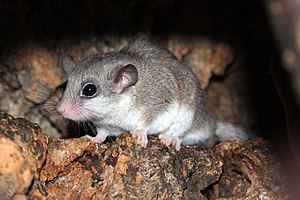nitedula
Νέµουσι δ' οἴκους καὶ τὰ ναυστολούµενα ἔσω δόµων σῴζουσιν, οὐδ' ἐρηµίᾳ γυναικὸς οἶκος εὐπινὴς οὐδ' ὄλβιος → They manage households, and save what is brought by sea within the home, and no house deprived of a woman can be tidy and prosperous
Latin > English
nitedula nitedulae N F :: dormouse
Wikipedia EN
A dormouse is a rodent of the family Gliridae (this family is also variously called Myoxidae or Muscardinidae by different taxonomists). Dormice are nocturnal animals found in Africa, Asia, and Europe. They are named for their long, dormant hibernation period of six months or longer.
Latin > English (Lewis & Short)
nītēdŭla: ae, f.,
I a kind of small red mouse, a dormouse, Cic. Sest. 33, 72: cf.: nitedula mus agrestis rubeus, Serv. ad Verg. G. 1, 181; Arn. 2, 47 (Hor. Ep. 1, 7, 29, the common read. is volpecula, but Bentley's conjecture, nitedula, is adopted by Lachm. ad Lucr. p. 204, and by Haupt and Müll.; v. Orell. ad loc.).—The contr. collat. form nītēla, v. under nitella.
Latin > French (Gaffiot 2016)
nītēdŭla,¹⁶ æ, f., petite souris, petit mulot : Cic. Sest. 72 ; Arn. 2, 47 ; Serv. Georg. 1, 181.
Latin > German (Georges)
nītēdula, ae, f. (nitor, ich klettere), ein Tier aus dem Mäusegeschlecht, die Haselmaus, Cic. Sest. 72. Arnob. 2, 47 (Hor. ep. 1, 7, 29 bloß Konjektur Bentleys, von Lachmann [Lucr. p. 204] wieder in Schutz genommen). – Andere Form nītella, Mart. 8, 37, 8. Plin. 8, 224 (vgl. über die Schreibweise nitella Lachm. Lucr. p. 204).
Translations
dormouse
Albanian: gjer; Armenian: քնամուկ; Asturian: llirón, llira; Basque: muxar; Belarusian: соня-палчок; Breton: lir, hunegan; Bulgarian: сънливец; Catalan: liró, rata dormidora; Chinese Mandarin: 睡鼠; Czech: plch; Danish: syvsover, hasselmus; Dutch: relmuis, hazelmuis; Esperanto: gliro; Estonian: kunel; Faroese: heslimús; Finnish: unikeko; French: loir; Friulian: glîr; Galician: leirón, lirio, liranco; German: Bilch, Bilchmaus, Schläfer, Schlafmaus, Siebenschläfer, Gartenschläfer, Haselmaus; Alemannic German: Haselmuus; Greek: δασομυωξός, μυωξός, ποντικοσκίουρος, μπλούχος, σπλήχος, πελέχι; Ancient Greek: γλῆρις, ἑλειός, ἐλειός, μυωξός; Hungarian: pele; Icelandic: heslimús; Irish: luch chodlamáin, dallóg fhéir; Italian: ghiro, moscardino, muscardinide; Japanese: ヤマネ; Korean: 겨울잠쥐; Ladin: ghiro; Latin: glis, nitedula; Latvian: susuris; Lithuanian: miegapelė; Macedonian: полв; Maltese: ġurdien ta' denbu pjuma; Mongolian: унтаахай; Norwegian: syvsover, sovemus; Occitan: missara, greule; Polish: popielica, pilch; Portuguese: arganaz; Romani: xurtso, xurtsaika; Romanian: pârș; Romansch: durmigliet, glirida; Russian: соня; Sardinian: topi de venadroxu, medrona de tzirva; Scottish Gaelic: dallag; Serbo-Croatian Cyrillic: пух; Roman: puh; Slovak: plch; Slovene: polh; Sorbian Lower Sorbian: pjelch; Upper Sorbian: lěsna myška, połch, połšk; Spanish: lirón; Swedish: sjusovare, sovmöss, hasselmus; Turkish: kakırca; Ukrainian: соня; Vietnamese: chuột sóc; Welsh: pathew; West Frisian: sânslieper

